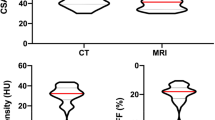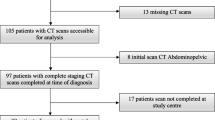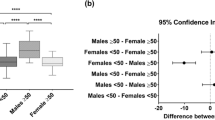Abstract
Objectives
To evaluate the correlation between simple planimetric measurements in axial computed tomography (CT) slices and measurements of patient body composition and anthropometric data performed with bioelectrical impedance analysis (BIA) and metric clinical assessments.
Methods
In this prospective cross-sectional study, we analyzed data of a cohort of 62 consecutive, untreated adult patients with advanced malignant melanoma who underwent concurrent BIA assessments at their radiologic baseline staging by CT between July 2016 and October 2017. To assess muscle and adipose tissue mass, we analyzed the areas of the paraspinal muscles as well as the cross-sectional total patient area in a single CT slice at the height of the third lumbar vertebra. These measurements were subsequently correlated with anthropometric (body weight) and body composition parameters derived from BIA (muscle mass, fat mass, fat-free mass, and visceral fat mass). Linear regression models were built to allow for estimation of each parameter based on CT measurements.
Results
Linear regression models allowed for accurate prediction of patient body weight (adjusted R2 = 0.886), absolute muscle mass (adjusted R2 = 0.866), fat-free mass (adjusted R2 = 0.855), and total as well as visceral fat mass (adjusted R2 = 0.887 and 0.839, respectively).
Conclusions
Our data suggest that patient body composition can accurately and quantitatively be determined by using simple measurements in a single axial CT slice. This could be useful in various medical and scientific settings, where the knowledge of the patient’s anthropometric parameters is not immediately or easily available.
Key Points
• Easy to perform measurements on a single CT slice highly correlate with clinically valuable parameters of body composition.
• Body composition data were acquired using bioelectrical impedance analysis to correlate CT measurements with a non-imaging-based method, which is frequently lacking in previous studies.
• The obtained equations facilitate a quick, opportunistic assessment of relevant parameters of body composition.



Similar content being viewed by others
Abbreviations
- BIA:
-
Bioelectrical impedance analysis
- CI:
-
Confidence interval
- CT:
-
Computed tomography
- DEXA:
-
Dual-energy X-ray absorptiometry
- MRI:
-
Magnetic resonance imaging
- SD:
-
Standard deviation
References
Bae KT, Tao C, Gürel S et al (2007) Effect of patient weight and scanning duration on contrast enhancement during pulmonary multidetector CT angiography. Radiology 242(2):582–589
Fernandes CM, Clark S, Price A, Innes G (1999) How accurately do we estimate patients’ weight in emergency departments? Can Fam Physician 45:2373–2376
Lorenz MW, Graf M, Henke C et al (2007) Anthropometric approximation of body weight in unresponsive stroke patients. J Neurol Neurosurg Psychiatry 78(12):1331–1336
Gascho D, Ganzoni L, Kolly P et al (2017) A new method for estimating patient body weight using CT dose modulation data. Eur Radiol Exp 1(1):23
Cubison TC, Gilbert PM (2005) So much for percentage, but what about the weight? Emerg Med J 22(9):643–645
Leary TS, Milner QJ, Niblett DJ (2000) The accuracy of the estimation of body weight and height in the intensive care unit. Eur J Anaesthesiol 17(11):698–703
Gallagher D, Kelley DE, Yim JE et al (2009) Adipose tissue distribution is different in type 2 diabetes. Am J Clin Nutr 89(3):807–814
Scherzer R, Shen W, Bacchetti P et al (2008) Comparison of dual-energy X-ray absorptiometry and magnetic resonance imaging-measured adipose tissue depots in HIV-infected and control subjects. Am J Clin Nutr 88(4):1088–1096
Buckley RG, Stehman CR, Dos Santos FL et al (2012) Bedside method to estimate actual body weight in the emergency department. J Emerg Med 42(1):100–104
Jang M, Park HW, Huh J et al (2018) Predictive value of sarcopenia and visceral obesity for postoperative pancreatic fistula after pancreaticoduodenectomy analyzed on clinically acquired CT and MRI. Eur Radiol. https://doi.org/10.1007/s00330-018-5790-7
Faron A, Pieper CC, Schmeel FC et al (2019) Fat-free muscle area measured by magnetic resonance imaging predicts overall survival of patients undergoing radioembolization of colorectal cancer liver metastases. Eur Radiol. https://doi.org/10.1007/s00330-018-5976-z
Lenchik L, Boutin RD (2018) Sarcopenia: beyond muscle atrophy and into the new frontiers of opportunistic imaging, precision medicine, and machine learning. Semin Musculoskelet Radiol 22(3):307–322
Shachar SS, Williams GR, Muss HB, Nishijima TF (2016) Prognostic value of sarcopenia in adults with solid tumours: a meta-analysis and systematic review. Eur J Cancer 57:58–67
Chang KV, Chen JD, Wu WT, Huang KC, Hsu CT, Han DS (2018) Association between loss of skeletal muscle mass and mortality and tumor recurrence in hepatocellular carcinoma: a systematic review and meta-analysis. Liver Cancer 7(1):90–103
Sconfienza LM (2019) Sarcopenia: ultrasound today, smartphones tomorrow? Eur Radiol 29(1):1–2
Sergi G, de Rui M, Stubbs B, Veronese N, Manzato E (2017) Measurement of lean body mass using bioelectrical impedance analysis: a consideration of the pros and cons. Aging Clin Exp Res 29(4):591–597
Lemos T, Gallagher D (2017) Current body composition measurement techniques. Curr Opin Endocrinol Diabetes Obes 24(5):310–314
Ward LC (2019) Bioelectrical impedance analysis for body composition assessment: reflections on accuracy, clinical utility, and standardisation. Eur J Clin Nutr 73(2):194–199
Kuriyan R (2018) Body composition techniques. Indian J Med Res 148(5):648–658
Gonzalez MC, Heymsfield SB (2017) Bioelectrical impedance analysis for diagnosing sarcopenia and cachexia: what are we really estimating? J Cachexia Sarcopenia Muscle 8(2):187–189
Chula de Castro JA, Lima TR, Silva DAS (2018) Body composition estimation in children and adolescents by bioelectrical impedance analysis: a systematic review. J Bodyw Mov Ther 22(1):134–146
Chien MY, Huang TY, Wu YT (2008) Prevalence of sarcopenia estimated using a bioelectrical impedance analysis prediction equation in community-dwelling elderly people in Taiwan. J Am Geriatr Soc 56(9):1710–1715
Prado CM, Lieffers JR, McCargar LJ et al (2008) Prevalence and clinical implications of sarcopenic obesity in patients with solid tumours of the respiratory and gastrointestinal tracts: a population-based study. Lancet Oncol 9(7):629–635
Derstine BA, Holcombe SA, Ross BE, Wang NC, Su GL, Wang SC (2018) Skeletal muscle cutoff values for sarcopenia diagnosis using T10 to L5 measurements in a healthy US population. Sci Rep 8(1):11369
Thurlow S, Taylor-Covill G, Sahota P, Oldroyd B, Hind K (2018) Effects of procedure, upright equilibrium time, sex and BMI on the precision of body fluid measurements using bioelectrical impedance analysis. Eur J Clin Nutr 72(1):148–153
Bosy-Westphal A, Jensen B, Braun W, Pourhassan M, Gallagher D, Müller MJ (2017) Quantification of whole-body and segmental skeletal muscle mass using phase-sensitive 8-electrode medical bioelectrical impedance devices. Eur J Clin Nutr 71(9):1061–1067
R Core Team (2014) R: A language and environment for statistical computing; Available via Available via: http://www.r-project.org/
Wickham H (2009) ggplot2: An implementation of the Grammar of Graphics. Available via Available via http://ggplot2.tidyverse.org/
Faron A, Luetkens JA, Schmeel FC, Kuetting DLR, Thomas D, Sprinkart AM (2019) Quantification of fat and skeletal muscle tissue at abdominal computed tomography: associations between single-slice measurements and total compartment volumes. Abdom Radiol (NY) https://doi.org/10.1007/s00261-019-01912-9
Kamiya N, Li J, Kume M, Fujita H, Shen D, Zheng G (2018) Fully automatic segmentation of paraspinal muscles from 3D torso CT images via multi-scale iterative random forest classifications. Int J Comput Assist Radiol Surg 13(11):1697–1706
Kazemi-Bajestani SM, Mazurak VC, Baracos V (2016) Computed tomography-defined muscle and fat wasting are associated with cancer clinical outcomes. Semin Cell Dev Biol 54:2–10
Shen W, Punyanitya M, Wang Z et al (2004) Total body skeletal muscle and adipose tissue volumes: estimation from a single abdominal cross-sectional image. J Appl Physiol (Bethesda 1985) 97(6):2333–2338
Geraghty EM, Boone JM (2003) Determination of height, weight, body mass index, and body surface area with a single abdominal CT image. Radiology 228(3):857–863
Irlbeck T, Massaro JM, Bamberg F, O’Donnell CJ, Hoffmann U, Fox CS (2010) Association between single-slice measurements of visceral and abdominal subcutaneous adipose tissue with volumetric measurements: the Framingham Heart Study. Int J Obes (Lond) 34(4):781–787
Lenchik L, Lenoir KM, Tan J et al (2018) Opportunistic measurement of skeletal muscle size and muscle attenuation on computed tomography predicts one-year mortality in Medicare patients. J Gerontol A Biol Sci Med Sci. https://doi.org/10.1093/gerona/gly183
Mintziras I, Miligkos M, Wächter S, Manoharan J, Maurer E, Bartsch DK (2018) Sarcopenia and sarcopenic obesity are significantly associated with poorer overall survival in patients with pancreatic cancer: Systematic review and meta-analysis. Int J Surg. https://doi.org/10.1016/j.ijsu.2018.09.014
Mei KL, Batsis JA, Mills JB, Holubar SD (2016) Sarcopenia and sarcopenic obesity: do they predict inferior oncologic outcomes after gastrointestinal cancer surgery? Perioper Med (Lond) 5:30
Deluche E, Leobon S, Desport JC, Venat-Bouvet L, Usseglio J, Tubiana-Mathieu N (2018) Impact of body composition on outcome in patients with early breast cancer. Support Care Cancer 26(3):861–868
Baum T, Lorenz C, Buerger C et al (2018) Automated assessment of paraspinal muscle fat composition based on the segmentation of chemical shift encoding-based water/fat-separated images. Eur Radiol Exp 2(1):32
Hashimoto F, Kakimoto A, Ota N, Ito S, Nishizawa S (2019) Automated segmentation of 2D low-dose CT images of the psoas-major muscle using deep convolutional neural networks. Radiol Phys Technol 12(2):210–215
Burns JE, Yao J, Chalhoub D, Chen JJ, Summers RM (2019) A machine learning algorithm to estimate sarcopenia on abdominal CT. Acad Radiol. https://doi.org/10.1016/j.acra.2019.03.011
Murphy J, Bacon SL, Morais JA, Tsoukas MA, Santosa S (2019) Intra-abdominal adipose tissue quantification by alternative versus reference methods: a systematic review and meta-analysis. Obesity (Silver Spring) https://doi.org/10.1002/oby.22494
Looijaard WGPM, Molinger J, Weijs PJM (2018) Measuring and monitoring lean body mass in critical illness. Curr Opin Crit Care 24(4):241–247
Funding
This study has received funding from the Koeln Fortune Program/Faculty of Medicine, University of Cologne (Koeln Fortune 339/2018 to N. Große Hokamp), and from the Else Kröner-Fresenius Stiftung (2016-Kolleg-19 to J. Knuever).
Author information
Authors and Affiliations
Corresponding author
Ethics declarations
Guarantor
The scientific guarantor of this publication is Daniel Pinto dos Santos.
Conflict of interest
The authors declare that they have no conflict of interest.
Statistics and biometry
No complex statistical methods were necessary for this paper.
Informed consent
Written informed consent was obtained from all subjects (patients) in this study.
Ethical approval
Institutional Review Board approval was obtained.
Methodology
• prospective
• cross-sectional study
• performed at one institution
Additional information
Publisher’s note
Springer Nature remains neutral with regard to jurisdictional claims in published maps and institutional affiliations.
Rights and permissions
About this article
Cite this article
Zopfs, D., Theurich, S., Große Hokamp, N. et al. Single-slice CT measurements allow for accurate assessment of sarcopenia and body composition. Eur Radiol 30, 1701–1708 (2020). https://doi.org/10.1007/s00330-019-06526-9
Received:
Revised:
Accepted:
Published:
Issue Date:
DOI: https://doi.org/10.1007/s00330-019-06526-9




